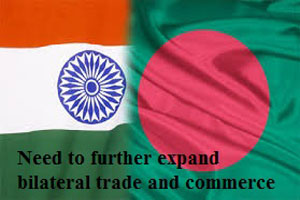
India, Bangladesh need to further expand bilateral trade and commerce
YarnsandFibers News Bureau 2015-02-27 18:00:00 – DhakaPaschimbanga Chief Minister Mamata Bannerjee during her recent visit to Dhaka observed that Bangladesh and Paschimbanga are the gateway to South Asia and there are enormous economic potential in areas that remains unexplored as yet. Mamata Bannerjee said that they can work together to make the two sides' business destinations for others. There are many potential areas including garment, textile, handloom, tourism, boutique and entertainment where both can work together.
With a view to tapping such potential, the existing infrastructure and road connectivity should be improved. The present level of connectivity has to be speedily expanded to benefit both the countries in a favourable situation.
Mamata Bannerjee rightly pointed out that there should be an immediate nurturing of the ties between the two sides in order to move forward. A joint business council is required to remove the obstacles faced by the businessmen. There should be a screening committee to identify the problems facing businesses on both sides.
As of now, exports to India did not rise up to the expected level due to para-tariff and non-tariff barriers. In fact, the trade imbalance with India is growing because of some bottlenecks.
There is an acute lack of infrastructural facilities along the bordering areas in the Indian state of Paschimbangla. Besides, India is not accepting BSTI (Bangladesh Standards and Testing Institution) certification. This is one of the major barriers to exports from Bangladesh.
However, there is a proposal from the Indian side about removing the barriers to trade with the joint efforts by the members of the business communities of both the countries and the governments.
Among the unresolved issues, there still exist two major disputes between the two countries -- land boundary agreement and the Teesta water sharing. For Bangladesh, these are very contentious issues which matter most to its teeming millions.
During the Chief Minister's visit, a memorandum of understanding was signed between the India-Bangladesh Chamber of Commerce and Industry (IBCCI) and the Indian Chamber of Commerce (ICC) to identify the genuine problems facing the businesspeople.
There was also an agreement about launching one more border market soon, in addition to the three already in operation to develop bilateral trade through the formal channel.
Generally, India exports goods worth more than $5.0 billion a year to Bangladesh through formal channels, and it is believed products worth another $5.0 billion enter Bangladesh through informal channels.
Two reasons --, non- and para-tariff barriers and the Lilliput issue -- have narrowed the scope for Bangladesh's exports to India. Some garment exporters of Bangladesh have otherwise been facing uncertainty for years in receiving payments worth $5.0 million from Lilliput, a leading kids wear brand in India.
Besides the countervailing duty at 12.5 per cent, there are some non- and para-tariff barriers for exporting garment items to India. On the whole, exports to India declined 19 per cent year-on-year basis in fiscal 2013-14 mainly due to a slowdown in shipment of garment items that do otherwise enjoy duty-free benefit in the neighbouring market.
Bangladesh's exports were expected to increase on account of this benefit that was given to it, following former Indian Prime Minister Manmohan Singh's visit to this country earlier. But due to the countervailing duty, Bangladeshi exporters lost competitiveness to the Indian garment manufacturers.
The Chief Minister of the Indian state of Paschimbanga has suggested to form a business channel between Bangladesh and her Indian state via Kolkata and Siliguri points as the latter locations are considered the gateway to business with Nepal, Bhutan and the 'seven sisters' of North-Eastern India.
There is, as market analysts say, also a large market worth $20 billion for Bangladeshi products in the north-eastern Indian states alone.
Furthermore, there is a long-pending visa problem with India. The Bangladeshi businessmen need multiple-entry visas to take advantage of the market opportunities in India. The neighbouring state of India can become the second biggest apparel market for Bangladesh after the European Union (EU) as the demand for Bangladesh's apparel items among the growing middle class there is high.
India and Bangladesh need to work together for further expansion of bilateral trade and commerce between them.
Market Intelligence
Ask for free sample Report

experience
Customer Base
dedicated team
Countries Served Worldwide









